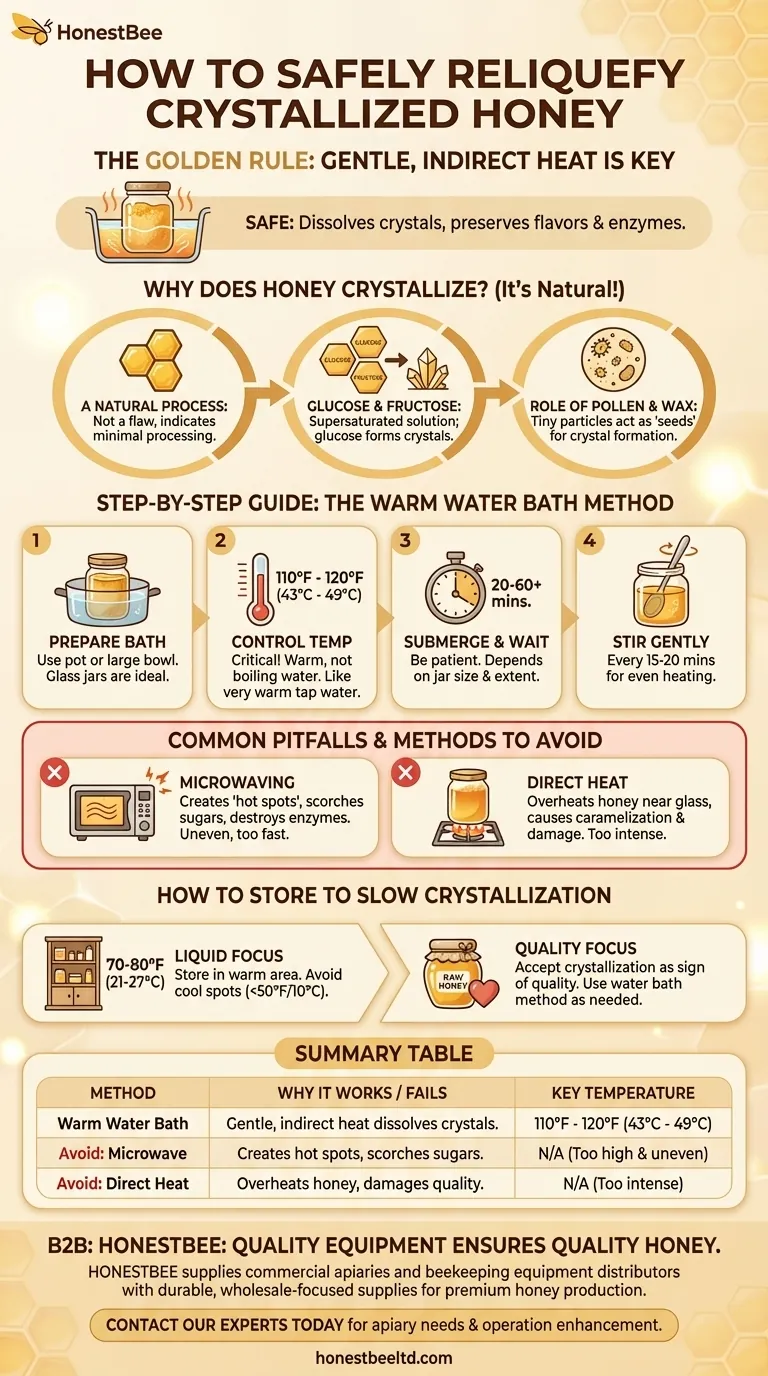The most effective method is to gently warm the jar of honey in a warm water bath. This process safely dissolves the glucose crystals that have formed without overheating the honey, which would damage its delicate flavors and beneficial enzymes. It is a slow, gentle process that restores your honey to its original liquid state.
The core principle is simple: gentle, indirect heat is the only way to reliquefy crystallized honey. Aggressive or direct heat, especially from a microwave, will scorch the sugars and destroy the very qualities that make raw honey special.
Why Does Honey Crystallize?
Understanding why honey crystallizes is key to appreciating its quality. It is not a sign of spoilage, but rather a hallmark of natural, raw honey.
A Natural Process, Not a Flaw
Crystallization is the process where honey transitions from a liquid to a semi-solid state. It is a completely natural phenomenon and a sign that your honey is minimally processed.
The Glucose and Fructose Ratio
Honey is a supersaturated solution of two main sugars: glucose and fructose. Glucose has a lower solubility than fructose, meaning it has a natural tendency to precipitate out of the solution and form solid crystals. The higher the glucose content in the honey, the faster it will crystallize.
The Role of Pollen and Wax
Raw, unfiltered honey contains tiny particles of pollen, propolis, and beeswax. These microscopic solids act as starting points, or "seeds," for crystals to begin forming. This is why highly filtered, mass-produced honey often remains liquid for much longer—it has been stripped of these natural catalysts.
The Step-by-Step Guide to Safely Reliquefying Honey
This method preserves the integrity of your honey. All you need is a pot or bowl and a source of warm water.
Prepare Your Water Bath
Place your jar of honey into a pot or a large bowl. If your honey is in a plastic container, you may want to ensure the water temperature remains on the lower end to avoid any risk of warping the plastic. Glass jars are ideal for this process.
Control the Temperature (The Critical Step)
Fill the pot with warm water, ensuring the water level comes up to the level of the honey but not over the lid. The ideal temperature is between 110°F and 120°F (43°C to 49°C). Think of it as very warm tap water, not boiling water. This is warm enough to dissolve the crystals but cool enough to protect the honey's delicate compounds.
Submerge and Be Patient
Let the jar sit in the warm water. The process can take anywhere from 20 minutes to over an hour, depending on the size of the jar and the extent of crystallization. You can gently stir the honey every 15-20 minutes to speed up the process and ensure even heating.
Common Pitfalls and Methods to Avoid
Using the wrong method can permanently damage your honey, altering its taste, color, and texture.
Why Microwaving is a Bad Idea
Microwaving is the fastest way to ruin good honey. It heats unevenly and far too quickly, creating "hot spots" that will scorch and caramelize the sugars. This process destroys beneficial enzymes and introduces a burnt flavor.
The Danger of Direct Heat
Never place a jar of honey directly in a boiling pot or on a stovetop. This applies too much intense, direct heat, which will overheat the honey near the glass. This leads to the same caramelization and degradation of quality seen with microwaving.
How to Store Honey to Slow Crystallization
While you cannot stop crystallization in raw honey forever, you can slow it down with proper storage.
- If your primary focus is keeping honey liquid longer: Store it in a pantry at a stable, warm room temperature (around 70-80°F or 21-27°C). Avoid storing it in cool areas, as temperatures below 50°F (10°C) will accelerate crystallization.
- If you value the quality of raw honey: Accept that crystallization is a natural sign of quality. Simply be prepared to use the gentle warm water bath method whenever your honey solidifies.
By understanding this natural process, you can easily restore your honey to its perfect liquid state without ever compromising its quality.

Summary Table:
| Method | Why It Works | Key Temperature |
|---|---|---|
| Warm Water Bath | Gentle, indirect heat dissolves crystals. | 110°F - 120°F (43°C - 49°C) |
| Avoid: Microwave | Creates hot spots, scorches sugars. | N/A (Too high & uneven) |
| Avoid: Direct Heat | Overheats honey, damages quality. | N/A (Too intense) |
For beekeepers and distributors, quality equipment ensures quality honey. Proper handling starts with the right tools. HONESTBEE supplies commercial apiaries and beekeeping equipment distributors with the durable, wholesale-focused supplies needed to produce, harvest, and store premium honey efficiently. Contact our experts today to discuss your apiary's equipment needs and enhance your operation's quality and yield.
Visual Guide

Related Products
- Professional Thermostatic Conical Honey Melter
- Honey Concentrating Vacuum Heating Thickening Machine Dehumidifier for Honey
- 0.5T Capacity Honey Dehumidifier Dryer with Vacuum Heating and Thickening Filtering Machine
- HONESTBEE 72 Frame Industrial Electric Honey Extractor for Beekeeping
- Electric 8 Frame Honey Spinner Extractor Equipment for Beekeeping
People Also Ask
- At what temperature does honey flow? Preserve Quality with the Perfect 95°F Sweet Spot
- How does the Bee Blanket help maintain honey quality? Preserve Enzymes with Gentle Hive-Mimicking Heat
- What are the negative effects of overheating honey? Preserve Your Honey's Natural Quality
- What equipment is commonly used for heating and processing honey? Essential Tools for Every Beekeeper
- What is melter honey used for? A Low-Cost Ingredient for Bakers and Brewers



















